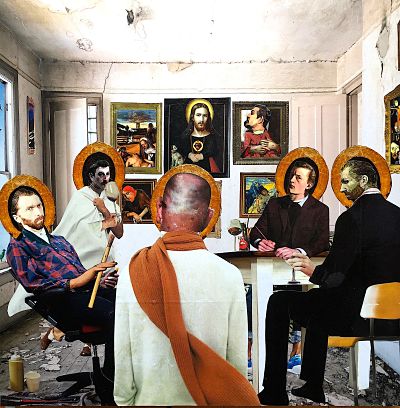
It’s All in the Headgear
February 2018. The term comes from the Greek and refers to one who bears witness. Renounces. Or refuses to renounce. Resists. Goes against the grain. And once a person take this route, they become involved in a kind of inevitability. Their action met by a counteraction. A corrective.
It’s the martyr I’m talking about. Funny the definition has to do only with the first part. The resisting. No one thinks of it like that any more. The term only makes sense when coupled with the result. And if people are ambitious for martyrdom, there’s little question about the end. Only about the degree perhaps.
Apparently some desire the ultimate martyrdom. Sophocles’ Antigone is in love with the idea. Obsessed. Others fall into it because of circumstances. Joan of Arc. She hears voices advising her to lead the French against the English. This pits her against the religious authorities and she’s duly punished. Burnt at the stake. She, unlike Antigone, is not anxious to die.
And then there are the artists. The Romantics. Symbolists. I’m reading bits from Rebels and Martyrs: The Image of the Artist in the Nineteenth Century (National Gallery Publications). No talk of death here but at the same time a definite identification with the suffering and martyred Christ. Delacroix. Feeling rejected, his work criticized, he begins to paint and identify with those who suffer: the poets, saints, martyrs and Christ. Gauguin. Identifying so entirely with Christ’s agony in the garden, he paints himself as Christ, the doubt and pain he feels as an artist his own particular agony. Van Gogh. He works from a print of the Pieta by Delacroix. Gives Christ his own features. The red hair. Occasionally he believes himself to be Christ. There are others. Munch. Goya. Ensor. And it is all these artists whom critic and writer Albert Aurier references when he writes: ‘the accursed..of the tribe of Christ and Homer/knowing what it is to be spat upon, knowing Crucifixion.’ This in his poem L’Oeuvre Maudit.
While it is clear these artists consider themselves martyrs and little Christs, I am a touch worried. Do they qualify? And who decides such things? Perhaps the National Gallery. They note that Delacroix was an apostle of modernism, one whose techniques and ideas fuelled the movements that followed. During his career he went against the grain, emphasizing the physicality of paint. Of color. Moved away from the status quo. The classical style. Art critics were unhappy with him. The art establishment opposed him. His punishment…bad reviews and an inability to get into the Academie des Beaux-Arts until late in life.
Paul Gauguin also experienced rejection during his life-time but later was recognized for a number of things including his experimental use of color and what was known as a Synthetist style. His innovations influenced those who came after him.
As for Vincent Van Gogh, his work was dismissed as amateurish and he sold only one painting during his life-time. Later it was said he invented a new kind of art called Expressionism.
While appreciating the contribution these artists made, the commitment each had to their particular vision, I remain uncomfortable with their identification as martyrs and Christ-like figures, suspecting them of making a meal of it, forcing a connection where there is none. I’d prefer them to leave it alone, to let history called them martyrs if it will. And it does…at least, in the title of the exhibition at the National Gallery in 2006 and the publication written up by Alexander Sturgis.
In his installation Martyrs (Earth, Air, Fire, Water), artist Bill Viola pays tribute to that ‘human capacity to bear pain, hardship and even death in order to remain faithful to one’s values, beliefs and principles.’ I’ll have to concede. Give that to those nineteenth century artists. And if they got a touch carried away with the label, they were, after all, Romantics.